Møhlenpris
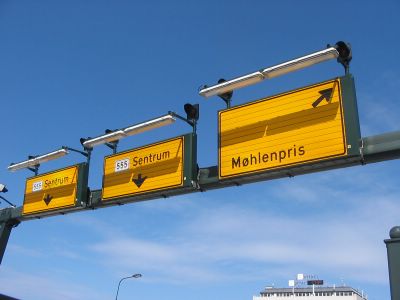
INTRODUCTION
We'll start our achingly slow journey through Bergen in the part of town that's called Møhlenpris, or Møllaren as the locals call it.
Not really a popular destination for globetrotters from around the world (although sea-legged and disoriented passengers from the Hurtigruten ship line can be seen wandering around, and sometimes late at night you´ll be able to spot Swedes looking for efterfest).
Even many of Bergen's own citizens have considered Møhlenpris to be something of an impasse: dull, gray and overshadowed by that hill to the north. Lies, lies, lies. Bergen doesn't have any sun, and thus no shadows. And really, this is a quite charming little place. More pictures shortly.
Overview
Separated from the centre of town only by the university area Nygårdshøyden, Møhlenpris is a quite central borough. Around 2000 people live here - one out of 125 Bergensere. Don't expect to see more than a few of them at the same time though (except at the occasional fire spectacle or at closing time Saturdays at the Spilde cornershop). Here's a map:

To the southwest lies Puddefjorden, admittedly not one of the more spectacular Norwegian fjords, but still found worthy of praise in the local song tradition. The dockside has traditionally been dominated by shipyard facilities, but with the current state of the industry and the ever growing demand for attractive residential locations, these premises are probably going to be reregulated for housing purposes.
As mentioned, the main traffic (pedagogically drawn in red) does not go through main Møhlenpris. The southern road is the only way to get here by car. Unless you are an adrenaline-fuelled excitement-seeking hedonist with no respect for authorities. Or just feel like taking a shortcut. But more on that later.
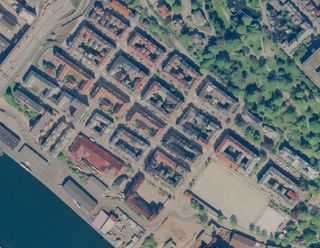
As evidenced by the picture Møhlenpris is a pretty askew neighbourhood, but don´t be fooled, from its inhabitants point of view it all looks quite normal. Feel free to take a detour to an unaffiliated site for a copyrighted view from above.
A RATHER FAR-FETCHED COMPARISON WITH OSLO´S ÜBER-TRENDY BOROUGH GRÜNERLØKKA
Although a lot smaller, Møhlenpris shares some of Grünerløkka's characteristics: Demographic profile and working class roots, proximity to city centre, architecture/street layout, semi-German name. Both have seen major renovation in the 80s and 90s.
But where Grünerløkka during recent years has experienced something of a renaissanse in the service and commerce department (with a zillion new cafés and bars and shops), in Møhlenpris the trend has been quite opposite. This once commercially thriving area now only sports a few shops. This has several reasons, mainly traffic regulation and market trends. Traffic - it's led outside the area (it used to run right through). Market - smaller shops have been forced out of business or into centralised shopping areas/malls. Bigger stores are unble to establish because regulations demand parking spaces that just aren't available in this contracted area. Thus, present-day Møhlenpris hosts a calm residential environment.
BRIEF HISTORY
In the medieval days Møhlenpris was a pasture-land for a monastary. Kings and queens swam in the lakes and Puddefjorden consisted of ale. In the 17th century Møhlenpris was born as a developed area, when trader and sly fox Jørgen Thormøhlen started various industrial activities (reperbane, soap boiling house etc). Following the proud local tradition of modesty, he was good-natured enough to let the place take his name.
Møhlenpris as we know it today, was born around 1890 when the streets were regulated in a quadratic grid. Brick apartment buildings (3-6 floors) with plastered surfaces dominate Møhlenpris, and most of these were built in the period between 1900 and 1920. The houses were built both for the workers and their leaders, and there was a divide between the cheaper and sparsely decorated houses to the west and south (closer to the dockside and shipping industries) and the roomier and more elegant buildings with front gardens to the east (close to the Nygårdsparken). This social and aesthetic divide remains today.
Enough rubbish, on to the pictures

I´ve yet to see a care tag read "wash at 45 degrees", but someone who left this washing machine alone to die here did so anyway. In the background the mailman, and even further behind is the Red Wall of Møhlenpris - its function is shielding the area from the dust and traffic that lures behind it. Or maybe it's there to spare the passing cars from the sight of these outlandish Møhlenprisians (or should we say Møhlenparisians?)

Above is a frequently updated view of Puddefjordsbroen courtesy of bt.no. Møhlenpris to the left. Gyldenpris on the other side of the bridge.
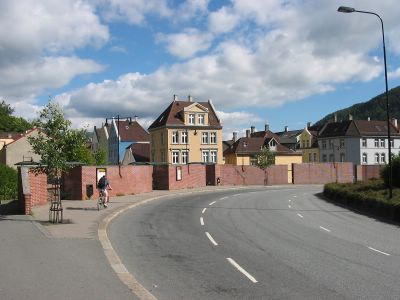
The other other side of the wall, the Outside, officially a part of Møhlenpris but not really. Not after they tore down the houses here to make room for the road system and the extension of the bridge, which is just to the right of the picture.
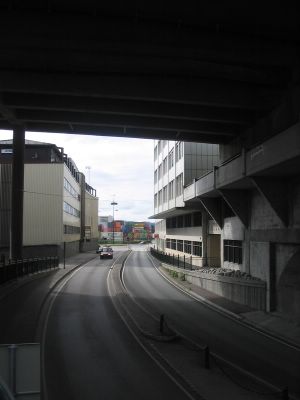
Under the bridge. The car in the picture appears to be headed straight for Møhlenpris, but the street-fighting kids of our proud borough need not worry. The roads goes into a tunnel that leads the traffic far away.
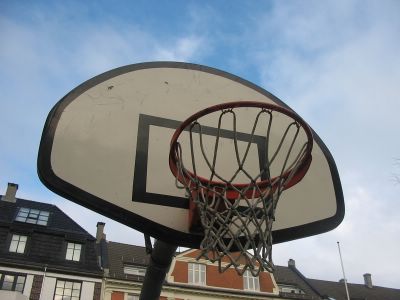
As an intermission from this exhaustive presentation we hereby present a real Møhlenpris basket case. Located in the schoolyard, which we will return to later. I can almost feel the audience tremble with excitement.

Back to the area behind the red wall again. Link to someone else's more advanced shot of the same spot.
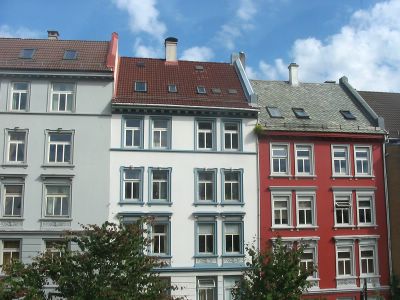
Like most things Bergensk, Møhlenpris is not flat.

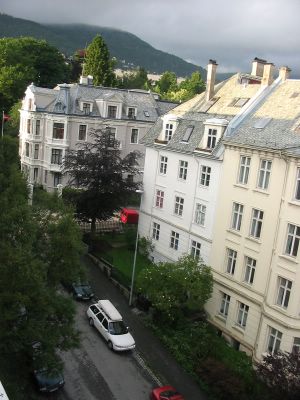
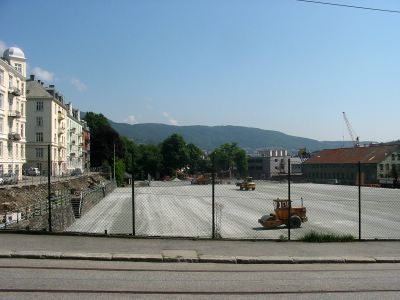
Lots of levelling work has been done though. Especially during the construction of this football ground.
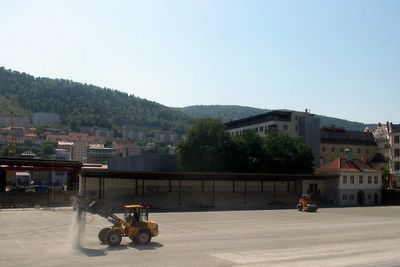
This place has been a popular playing field for a century. Before Brann stadion and other major grounds were built, this was Bergen's main football arena. There are still charming little stands around it, where a few locals gather to watch the games, maybe a drunk or two clinging on to a warm and soothing can of the preferred local brew of Hansa. The attendance isn't what it used to be though. In the early years workers rallies were held here, and Russian anarchist thinker Kropotkin is said to have made a speech here in front of 20 000. Cliff Richard did a notoriously short show here in 1961 where he had to flee the stage because of unruly teenagers in front of the stage. Attaboys!
In these pictures, the ground is being rebuilt. After a century of being covered with gray and dusty gravel (and sometimes ice in the winter), it's finally getting the proper football field colour of green. Grass is too expensive to maintain in the Norwegian climate, so astroturf will have to do.
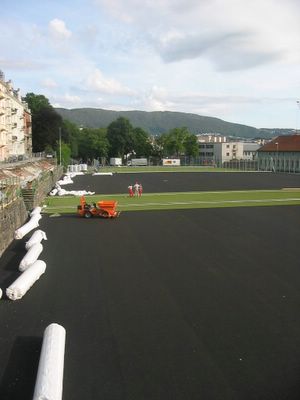

Right next to the ground (and the Nygårdsparken) one finds the posher side of Møhlenpris. The streets here are wider, allowing more light and space for neat front gardens.
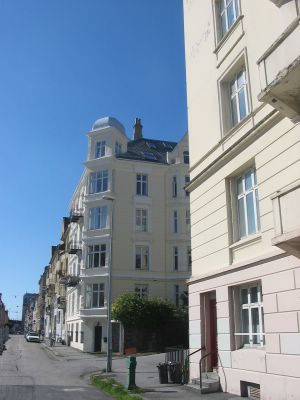
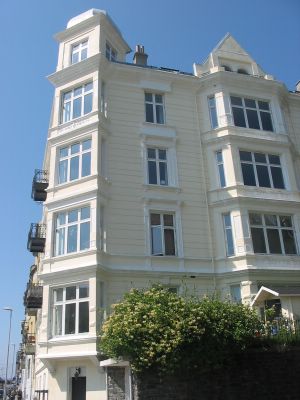
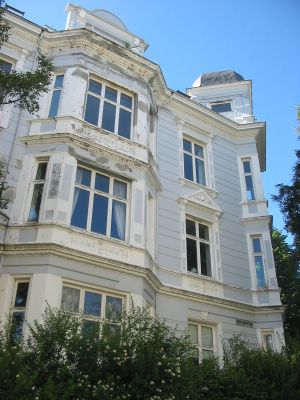
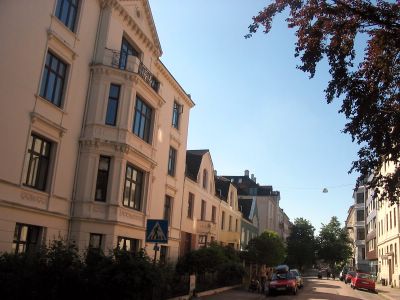
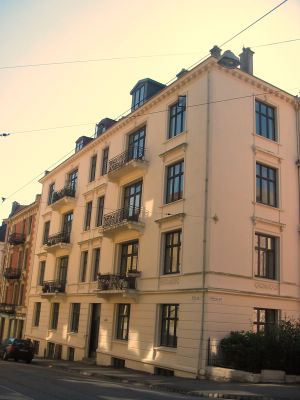

Welhavens gate ends and the lovely Nygårdsparken begins. We won't be going there today, though.
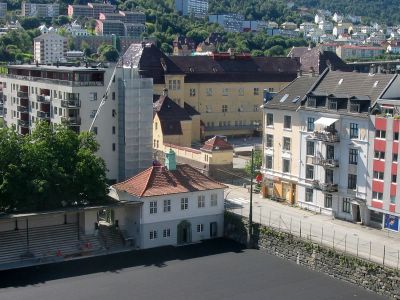
A view to the south. Behind the ground and the old clubhouse lies the new Vitalitetssenteret and the school.
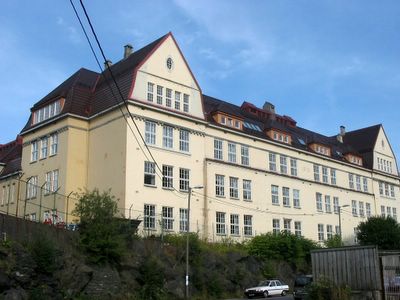
Møhlenpris school seen from the dockside. As with many of the other early 20th century schools in Bergen it is drawn by municipal architect Kaspar Hassel, and like many of the other early 20th century schools in Norway it appears as if it could fall apart any second.

The hideous building that casts shadows over the schoolyard might look like the council estates often seen in those early 90s socially conscious British police-series. But don't be fooled, it's a community centre, with a sports hall, a cafe and apartments. When Vitalitetssenteret was finished a couple of years ago it was a victory for those who had fought for it the last 20 years. A shame about its appearance though.
The mantra of most architects is "be true to your time". New buildings drawing inspiration from heritage rather than modern trends are "dishonest", apparently. They say that every generation should contribute its distinctive features to the city landscape, because if a place looks too old, it becomes an unlivable museum. Oddly though, you never hear anyone moaning about Rome or Florence or Prague looking too much like a museum.
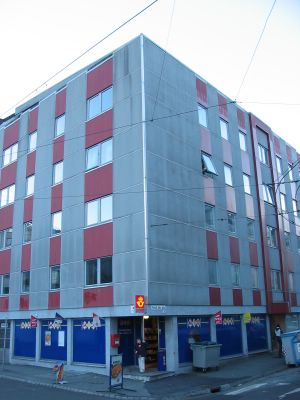
Now, the architects' doctrine would have been rather smart if every generation of architects actually contributed anything of lasting value. Sadly, this is not the case in Bergen. And not too surprisingly, the most recent contributions to Møhlenpris architecture doesn´t impress anyone. Fortunately though, modern buildings are few.
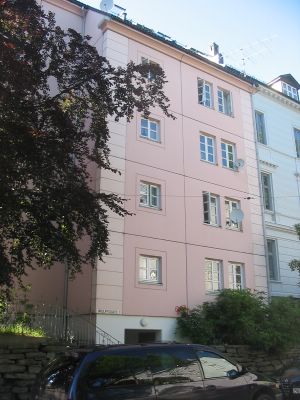
Of course it is possible for a modern house to fit in nicely with its surroundings - as the building above examplifies.
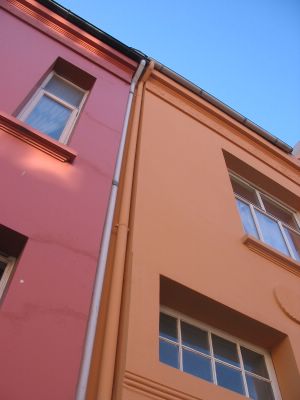
United colours of Møllaren. Konsul Børs gate is dominated by reds and oranges. The simple wall surface is typical of this part of Møhlenpris.
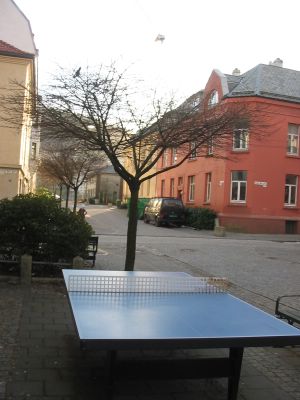
This area was renovated around 10 years ago, with pedestrian areas and "community-furniture" like basket cases and this ping-pong-table.
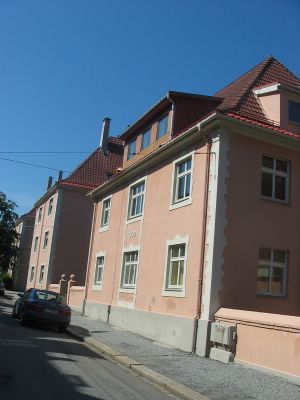
Following the big conflagration of 1916 that ruined the city centre (link to excellent visualisation of Bergen fires), a lot of people were left homeless. This is one of three huge and identical blocks of flats that were raised to answer the housing shortage.
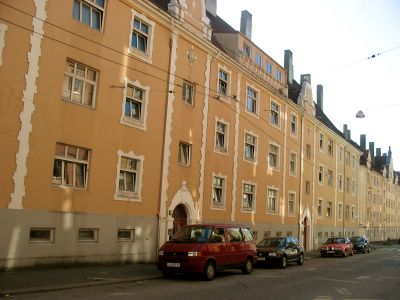
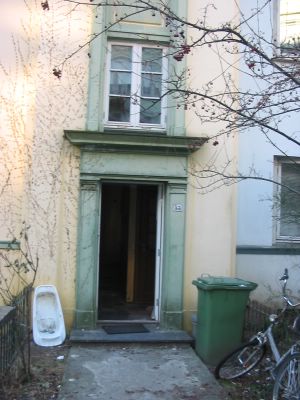
Shabby, yet charming entrance
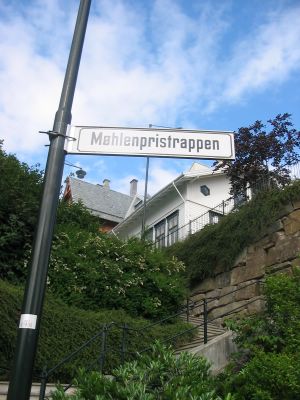
Exits from Møhlenpris (and entries to Nygårdshøyden/the university area) includes Møhlenprisbakken (Møhlenpris hill), the new and neat Møhlenpristrappen (Møhlenpris stairs), different paths through the park and Olaf Ryes vei.
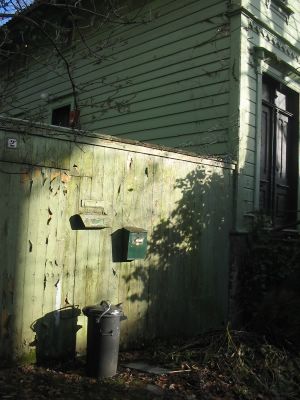
A little green house caught inbetween Møhlenpris and Nygårdshøyden.
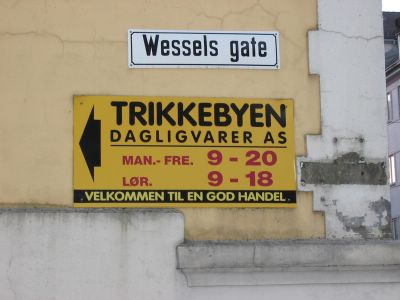
A sign that speaks of the long gone commercial finest hour of Møhlenpris, there are many similar that noone bothered to remove. Trikkebyen means "tram town" and refers to a small area of Møhlenpris that was built to accomodate the workers on Bergen Elektriske Sporvei (the old public transport company).
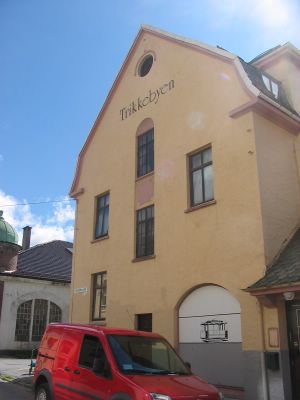

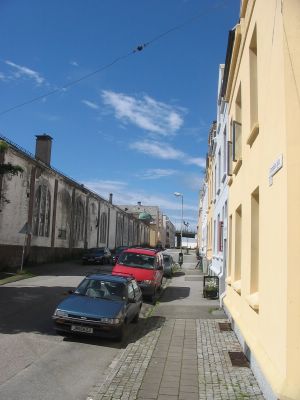
At the heyday of trackbased transport in Bergen there were several tram lines, one of which had Møhlenpris as its terminal. The tram line apparently corresponded with the ferry that transported passangers over Puddefjorden - this was before the construction of Puddefjordsbroen (a bridge that is mentioned alongside London Bridge and Golden Gate in a Kings of Convenience-song). This building housed the cars, now it is a low budget "home-made"-styled museum showing old buses and engines.
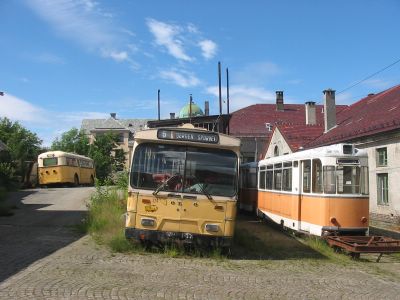
The tram lines were shut down one by one, and in the 60s the cars were dumped in Puddefjorden.
Those familiar with the work of Thorbjørn Egner might recognize this part of Møhlenpris' Egneresque qualities. There's even a small yellow tram running here on Sundays, the sad ringing of the tram against the tracks alerting everyone on Møhlenpris of its business. A single car escaped its Puddefjord doom, and tram enthusiasts around Bergen Tekniske Museum keeps it nice and shiny, along with the other vehicles there. They are working on a new musem line: Every few years they add some metres to the line, the plan being one day to reach Engen (more on the plans).
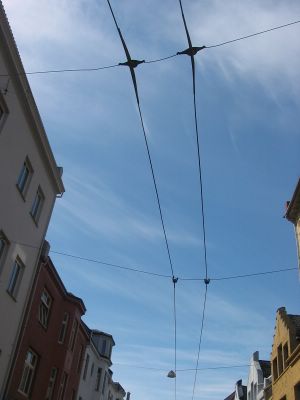
Overhead wires remind us of the trolley line that used to run here.
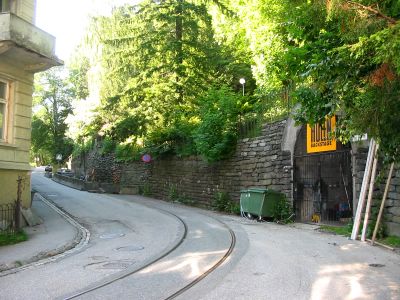
These days the train tracks stop outside Hulen
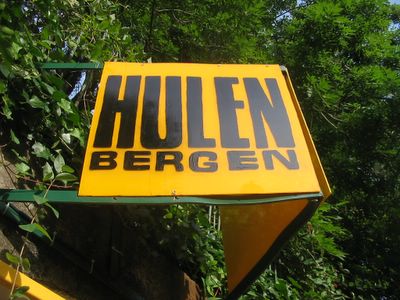
Hulen ("the Cavern") is a legendary place- they say it's northern europes oldest rock club. It is an old air raid-shelter turned in to a club for students in the late sixties, and it is quite a fantastic place with its cavelike interior. Mainly open from thursday to saturday, and unfortunately the only place on Møhlenpris serving beer. Authorities are very strict with granting licences to serve alcohol, they do not seem to understand that a city's urban qualities are (in part) defined by the number and variety of meeting places - pubs, restaurants, museums, parks.
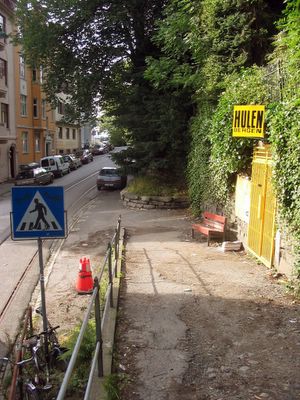

One of two grocery's shops left on Møhlenpris. The traditional Follesø became a chain-store some years ago. It's hard to translate this sign properly but let's say its defensiveness suits the place nicely...
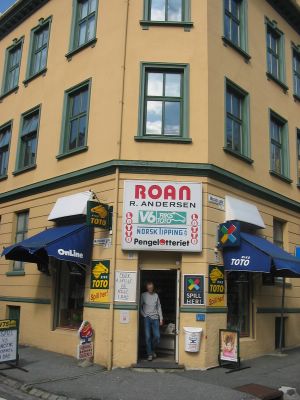
This place sells horse bets, newspapers, candy and toys(!). It's been here for decades, as evidenced by the main sign that shows outdated logos and brands.
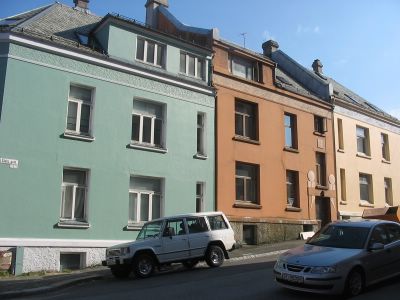
Stubs gate, one of the smallest streets around.
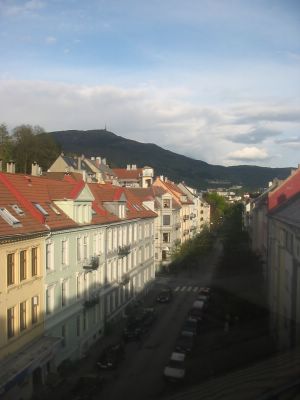
View from a rooftop. In the background Mount Ulriken trying to look smaller than it really is. Succeeding.

Sunset hour. Far away, Haukeland (the hospital) is visible.

This road connects Møhlenpris to Nygårdshøyden and the university area. When it was first built it increased the accessibility of Møhlenpris enough to shift its status from distant farmland to a genuine part of town. These days traffic here is restricted to buses and taxies, but as evidenced by this picture: Not everyone bothers to take the long way round.
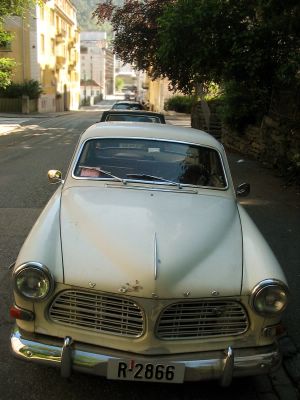
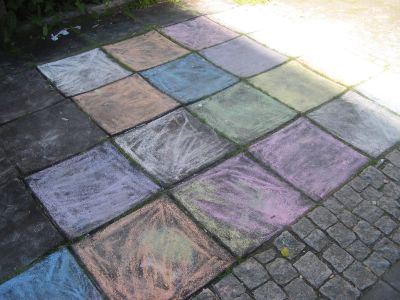
In the holidays Kids dominate the area, their hollering and ground paintings omnipresent.
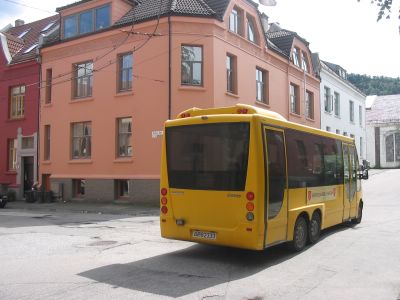
The service line for the elderly and disabled.
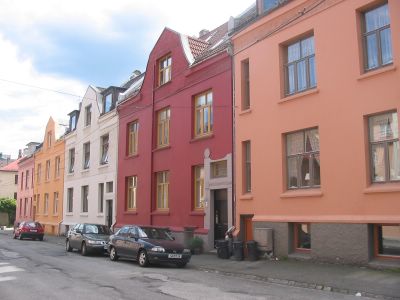
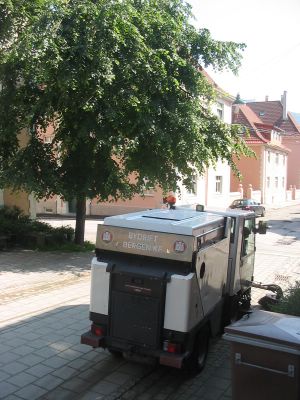
Now this vehicle doesn't come by as often, but it is more than welcome, sweeping the streets.

And there's more of a need for street sweeping than we like to admit. Unforunately a lot of the residents don't seem to understand the not too complex concept of a garbage bin.
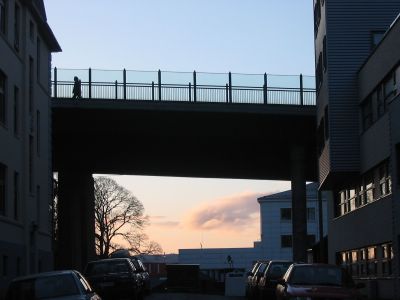
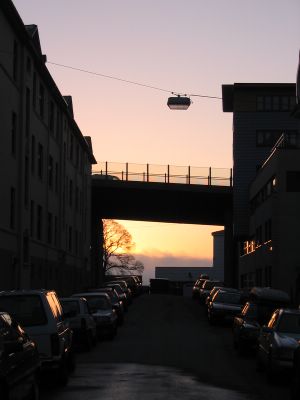
View from Konsul Børs' gate to Puddefjordsbroen in the evening
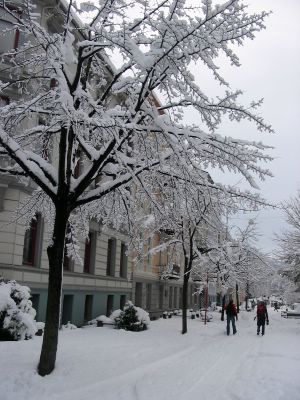
Bergen is not the coldest place and heavy snow is not common. We have a few snow periods each winter, though.
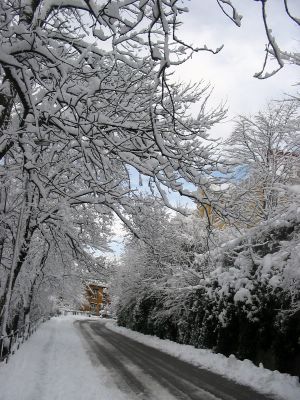
Olaf ryes vei
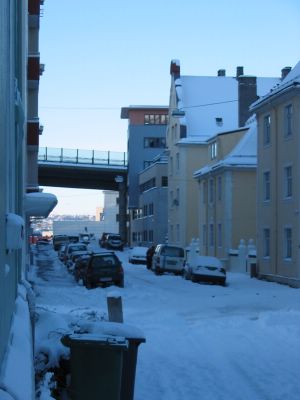

Nordahl Grieg was a writer in most senses of the word: Playwright, poet, novelist and journalist. He grew up in this house.

Grieg died on a war correspondent mission when his bomber was shot down over Berlin in 1943. "Erect no monuments" says one of his poems, but someone chose to honour him with this plaque anyway.
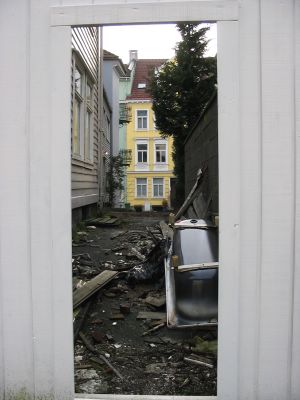
Junk in a backyard.
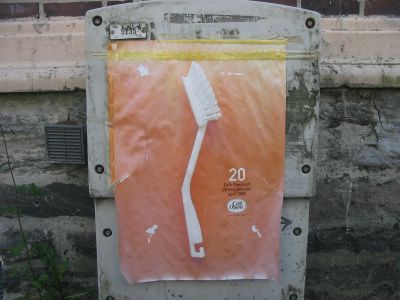
Poster for the 20th aniversary of Café Opera downtown. We conclude our walk through Møhlenpris with some random entrances.

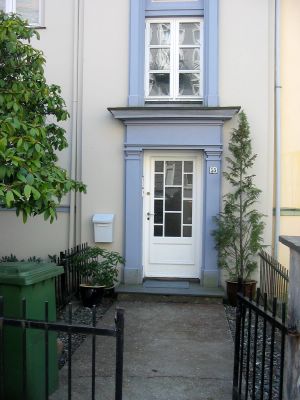
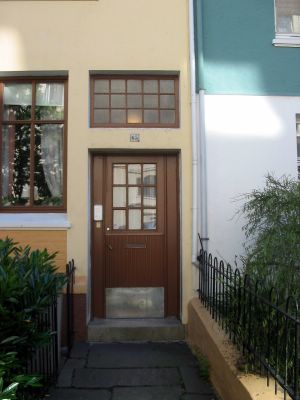
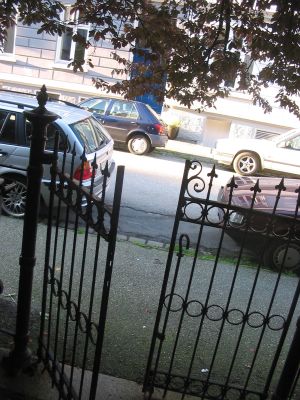
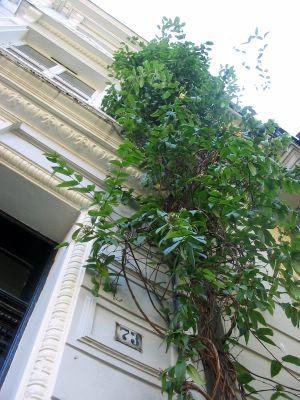
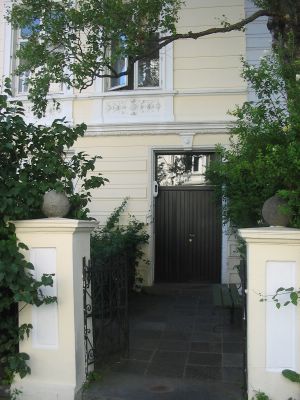

16 Comments:
når kommer episode 2? :-)
Det kan nok fort gå en stund, dessverre. Tar litt tid og man har nok av både mer og mindre fornuftige ting å ta seg til. Men til våren når blader og sol returnerer satser jeg på å ta kameraet fatt og tusle over Høyden...
Åh, det søkker i magen når man ser eksteriørfoto av sin fordums studenterleilighet i Bjerregardsgate 1...sukk og søkk! (forøvrig den eneste gate i Bergen med bare ett nummer!!)
Utrolig bra dokumentert! Du har virkelig fanget Møhlenpris.
You've got too much spare time ;)
Exellent work i1277!
Keep on posting
veldig bra. jeg er spent på å se det som kommer etterpå!
God tekst og fantastiske bilder! Fant til og med et bilde av min egen eks-inngang, omtalt som shabby men sjarmerende. Sender siden sporenstreks til alle tidligere kollektivkamerater.
La nostalgien flyte fritt!
eks-welhavensgate 53damen
men det bildet fra professor hansteens gate mot broen er egentig fra konsul børs' gate. hehe.
Observant av deg, men sløvt av meg, det er jo min egen gate...
Takk! Eg er ein møhlenpris patriot, og dette var hyggjeleg!
Jeg er vokst opp i Professor Hansteens gate. Dette var bra med mange fine bilder og stort sett saklig omtale.
Eg tillot meg sjøl å reklamere for bloggen din i vår dugnadsinspirerte "Møhlenpris avis: http://www.origo.no/-/workgroup/show/2491_moehlenpris-avis
håpar det er greit!
Spørsmålet er:
vil det noen gang komme en oppfølger?
Susanne: Kjekt det.
Anonym: Håper det. Har ikke hatt kamera på noen år, men det blir det vel en ordning med etter hvert. Ambisjonene tilsier et jevnt, men rolig tempo.
obat kutil kelamin
obat kondiloma
ada benjolan kecil dan gatal di kelamin
pengobatan kutil yang tumbuh di kelamin
salep kutil kelamin
ada benjolan bintik bintik di kelamin
obat kutil kelamin pada wanita
obat kutil kelamin pada pria
obat kondiloma ampuh
obat kondiloma gatal gatal
obat kondiloma berdarah
Ambeien dapat disembuhkan dengan mengonsumsi Obat ambeien , aman, halal, dan terjangkau yang bernama ambeclear. Tanaman Herbal yang bernama tanaman daun ungu merupakan bahan utama dari ambeclear. Silahkan baca artikel selengkapnya . Jika OBAT KUTIL KELAMIN medis ini ternyata juga tidak memberi kesembuhan, maka pengobatan alternative yang bisa menjadi pilihan adalah Obat kutil kelamin. OBAT HERBAL KUTIL KELAMIN ini lebih alami dan tanpa efek samping seperti pengobatan kimia lainya. Silahkan baca artikel selengkapnya. Setelah mencoba bertanya kepada orang-orang akhirnya dia menemukan OBAT KLAMIDIA yang ampuh dengan khasiat alami. Obat klamidia ini merupakan obat yang seratus persen menggunakan bahan yang diambil dari alam. Silahkan baca artikel selengkapnya. Obat alat vital bernanah secara alami ini lain daripada yang lain. Pengobatan ini berbeda dengan pengobatan pada umumnya. Karena kita ketahui sendiri pengobatan ini lebih menekankan dengan penggunaan bahan-bahan alami yang seratus persen berasal dari alam. Silahkan baca artikel selengkapnya.
Post a Comment
<< Home